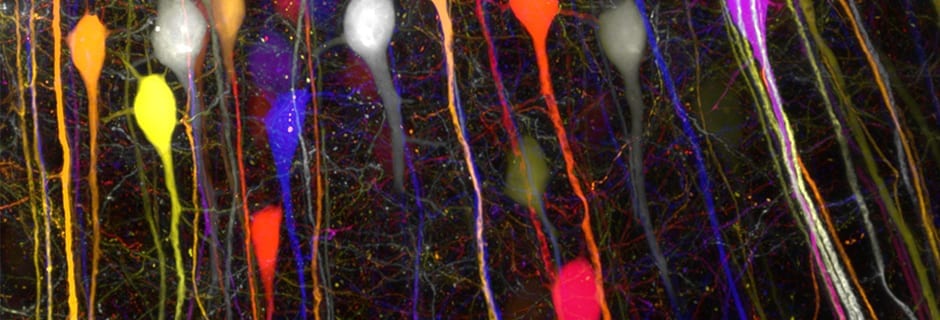Above: Image of cleared mouse brain 600x600x640 microns thy1-GFP Actin Fire coloured height map. Courtesy of Dr Anthony Vernon and Robert Chesters, Department of Basic and Clinical Neuroscience, Maurice Wohl Clinical Neuroscience Institute, Institute of Psychiatry, Psychology and Neuroscience; MRC Centre for Neurodevelopment Disorders, King’s College London
[title size=”4″]Innovative research using ultra-pure lasers, led by the University of St Andrews and M Squared, will help in the search for effective ways to diagnose and treat dementia and cancer, which are claiming more and more victims in ageing populations.[/title]
Funding of over £1.4 million for the revolutionary research will come from the EPSRC Prosperity Partnerships and the Industrial Strategy Challenge Fund (ISCF), and industry partners.
The aim of the project is to address global healthcare and biomedical challenges using advanced photonics solutions developed by the University of St Andrews and M Squared Lasers. Centered around four ambitious research themes at the interface of biology, medicine and photonics, the outputs will benefit researchers and practitioners looking for new ways to address issues such as the diagnosis and treatment of dementia and cancer. The close collaboration between academia and industry, with an emphasis on exploitation of IP and innovation, will deliver a series of high impact outcomes across the sector.
“The potential for us to drive forward new research ideas with the goal of creating real tangible benefi t for UK’s societal needs is very inspiring,” said Kishan Dholakia, Professor of Physics at the University of St Andrews. The project has an emphasis on industrially-relevant outcomes; in particular, the development of early-stage light-based tools and techniques.

Kishan Dholakia, Professor of Physics at the University of St Andrews
New approaches to biological imaging, laser analytics and photonic instrumentation will be explored over a time-frame of five years.
“Biophotonics and laser-based innovations can have a huge impact in medicine,” said Dr Graeme Malcom OBE, CEO and Co-Founder of M Squared. “Our work with research partners, in particular the University of St Andrews, brings our technology much closer to the sectors – including medicine, industrials and even quantum computing – where our work can have the largest impact. We have a lot of confidence in this project, made possible by the EPSRC.”
Biophotonics is a combination of biology or medicine and photonics (the science and technology of generation, manipulation, and detection of light). The international growth in photonics investment needs to be mirrored by a similar expansion of corresponding UK strengths at the University-Industry interface, which is at the heart of this EPSRC Prosperity Partnership.

Dr Graeme Malcolm, OBE, CEO and co-founder of M Squared
The four research challenges will deliver: a suite of new single and multiphoton light sheet microscopy products; new applications of Raman and fluorescent analysis; measurement of laser wavelength and spectra; development of a new suite of ultra-compact super-resolution microscopes for pathology and disease management.
“One key area we’ll be exploring is the use of light-scattering, which can be used in the fight against cancer by accurately distinguishing between normal and unhealthy cells and tissue,” Professor Dholakia said.
M Squared aims to rapidly bring new innovations from the University out of the lab and into the real-world through its life sciences division, M Squared Life. The Biophotonics Nexus will enable job creation and revenue growth through the focused expansion of M Squared’s laser, microscope and instrumentation product lines.

